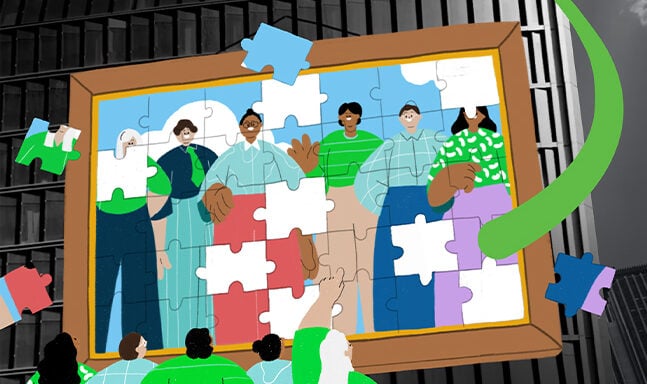People & Leadership
Top trends in HR in 2023: 9 HR priorities and how tech can help
From managing hybrid working and supporting employee wellbeing, to using virtual reality and AI, discover the top HR priorities in 2023.

New year, new agenda?
With the great resignation, the economic downturn and embedding hybrid working, HR had a lot of challenges on their plate in 2022, so can the sector expect a continued bumpy ride in 2023 – or is it the year HR can finally catch their breath?
We’ve picked the brains of HR and People experts to help shine a light on nine HR challenges and priorities they felt HR can expect in 2023 and how technology can play a role in solving these.
Here’s what we cover in this article:
- 1. Hybrid working and working from home is here to stay
- 2. Embed healthier company cultures that enable employees to be ‘human at work’
- 3. Employee wellbeing and mental health support continue to be a big concern
- 4. Notification overload: Balancing technology use and wellbeing is vital
- 5. Elevate HR with emerging technologies to free up time
- 6. Master digital trust in the workplace
- 7. Create compelling, personalised and differentiated employee experiences
- 8. Double down on HR tech investment
- 9. Get more familiar and comfortable with people analytics
- Looking ahead in 2023
1. Hybrid working and working from home is here to stay
Although hybrid working has become more commonplace, there’s still some bedding in to be done in 2023 to ensure both employees and employers are satisfied with new ways of working.
Nearly one in five (17%) HR leaders say hybrid working will be a priority for them over the next three years.
“Most organisations are beginning to accept that employees are not going to return to a five-day week in the office,” says Devyani Vaishampayan, CEO of The HR TECH Partnership.
“Rethinking how people management needs to happen – such as onboarding, feedback, coaching, learning, and wellbeing – is going to be the single biggest challenge in 2023.”
Susan LaMotte, CEO and Principal Strategist at exaqueo, agrees. She explains:“Employment is a relationship – and employees are clearly demonstrating they are not going back to the way things used to be. HR leaders will have to both accept, coach, and drive their organisations to shift.”
Gemma Dale, Senior Lecturer at Liverpool John Moores University, believes we are still very much in a “test and learn phase” of new ways of working and there is much to be done to embed these new working practices.
Jon Ingham, Director of the Strategic HR Academy, adds that this where technology can really help: “Current return to office strategies are generally not succeeding in reinstalling the same in person connections we used to experience, so technology needs to step up.”
2. Embed healthier company cultures that enable employees to be ‘human at work’
With record numbers of people that quit their jobs during the great resignation in 2022, and top talent reassessing what they value most about their workplace, creating a healthy company culture is a top priority for HR and business leaders in 2023.
In fact, both HR and the C-suite rated keeping top talent as their number one priority in Sage’s recent Changing face of HR research report.
“We can create healthier cultures with transparency, autonomy, control, a sense of belonging, connectedness and authentically lived purpose and values,” explains Jenn Lim, co-founder and CEO of Delivering Happiness.
“These are not necessarily new trends, but they’re happening in a new time and context.”
Post-pandemic, there’s been a fundamental shift in how people reprioritise their time and a focus on finding more meaning and value from the work they do.
According to Jenn, this means what HR does and how they do it has never been more “scrutinised, expected and important”.
To create healthier company cultures, she advises that HR and People leaders need to establish new social contracts with their teams and people.
“Look for new and creative ways to listen and adapt so we can be more human at work,” she says. “Then ask how HR tech might support those changes.”
HR tech can support driving hybrid company cultures, but Jenn explains that to get the most out of it, it’s important to make decisions around HR tech that are “aligned with your company’s purpose, values, and behaviours”.
Although the pandemic meant company culture took a bit of a back seat for a while, 56% of HR leaders say they’ll be leading the charge and making this a focus over next three years.
3. Employee wellbeing and mental health support continue to be a big concern
What’s the single biggest challenge facing HR leaders right now?
Sankalp Chaturvedi, Professor of Organisational Behaviour and Leadership at Imperial College Business School, believes it’s supporting employees’ mental health and wellbeing.
With the economic downturn, this area is going to remain a key challenge for HR leaders in 2023.
Sankalp says: “Employees, and people in general, have been exposed to constant extreme uncertainty from environmental pressures and geopolitical situations affecting their daily work-home lives.
“HR will need to upskill its employees and business leaders to identify mental health problems before they become unmanageable problems.”
April Marcot, Chief People Officer at McArthur, predicts the focus for 2023 will be on physical, mental and emotional health of employees, “supported by gamification and wearables”.
She adds: “I look forward to seeing technology integrated into LMS [learning management system], HRIS [human resources information system] and recognition platforms.”
4. Notification overload: Balancing technology use and wellbeing is vital
Although digital transformation has brought about many benefits, Sankalp Chaturvedi points out that it has also triggered mental health problems for some employees, due to the “turbulent and unforgiving environment” created by intensive remote working and sole technology-based interactions.
But Jon Ingham believes technology can also be an enabler for generating more human-based connections.
He says: “We need to master asynchronous communication, and reduce the increased organisational drag resulting from ineffective use of current technologies.”
65% of HR leaders say they will be playing a leading role in employee health and wellbeing over the next three years. Understanding where and how technology can support and complement employee wellbeing is going to be key to getting it right.
5. Elevate HR with emerging technologies to free up time
A key challenge for HR leaders wanting to stay ahead in 2023 is how to use newer technologies such as augmented reality (AR), artificial intelligence (AI), virtual reality (VR) and extended reality (XR) in their day-to-day HR practices.
Gemma Dale believes these new emerging technologies will have a significant impact.
She says: “Many aspects of the employment lifecycle like recruitment or the provision of learning and development could be transformed with these.”
While they are not yet mainstream, she says HR should be looking ahead and identifying how these technologies can support new ways of working both in HR and the wider organisation.
Gemma adds: “We don’t need to leave this to the IT teams. When introducing these technologies, we need to also implement them with due concern for fairness, diversity and inclusion.”
Fewer than half (47%) of HR leaders are using AI today, our latest research found, so HR leaders have an opportunity in 2023 to lean on these emerging technologies more and free up time to focus on more strategic work.
6. Master digital trust in the workplace
Digital trust is the confidence employees have in the ability of people, technology and processes to create a secure digital world while they are at work.
And it’s something that HR leaders and their organisations will need to master in 2023.
Sankalp Chaturvedi says: “With less regulation in the digital industry, the need for a secure digital world wherein employees can trust the environment without being worried of the fraud is getting more and more important.”
Although digital trust is typically centred around companies proving to users that they can provide safety, privacy, security, reliability and data ethics with their online programs or devices, Perry Timms, founder and Chief Energy Officer of PTHR (People & Transformational HR), points out that monitoring employees’ work performance using tech can also cause digital mistrust.
He says: “HR needs to know how to resist ‘spyware’ in favour of more open and transparent ways to allocate, track and report on work being done in a fair and useful way to balance workloads and predict resource allocation.”
He suggests that HR leaders should “push back on monitoring work and people’s performance, in favour of more open and transparent ways to show workflow, workload and subsequent performance.”
“Analysing where people huddle, who they link with and why, helps HR understand the dynamic of supportive colleagues,” explains Perry.
7. Create compelling, personalised and differentiated employee experiences
Employee experience isn’t going away. In fact, it’s even more important in the new climate of work. 83% of HR leaders agreed employee experiences will become even more of a focus for HR, our research found.
However, creating employee experiences that work isn’t enough. The challenge for HR will be creating a “compelling, differentiated employee experience” in 2023, says Emma Bridger, founder and Managing Director of People Lab.
She says: “To attract and retain the best talent now means genuinely knowing and understanding your people at a level we have never known before.
“It is only by doing this that we can design and deliver employee experiences which differentiate.
“Start by understanding what you mean by employee experience in your organisation and which teams and departments can control or influence it.”
With so much work on HR’s plate, getting employee experiences right means making sure they’re specific and targeted.
Emma says: “Don’t try to boil the ocean, get clear on your priorities. Then invest time and energy in really getting to know your people and ensure any solutions you develop are grounded in insights, not assumptions.”
Emma advises to look for “HR tech that consolidates employee data from a range of lifecycle touchpoints” as well as tech that can help HR and People teams both understand their people through data and facilitate the end-to-end employee experience.
8. Double down on HR tech investment
Over the past three years, investment in HR tech has accelerated – largely driven by the pandemic. But over the next 12 months, the challenge for HR will be around execution and driving adoption.
Ben Brooks, founder and CEO at PILOT, predicts this will include proving that investments made in new programmes and HR tech are paying off.
He says: “I predict far more rigor and inspection into the actual impact and ROI [return on investment] of enterprise technology tools in 2023.”
He says to meet this challenge will require HR leaders to achieve “new levels of programme management capability, consistency, leverage of data and analytics, and overall command and influence within their organisation”.
Ben adds HR leaders should “attend conferences, vendor events, virtual events, and network with other HR pros to trade notes on platforms, adoption strategies and more”.
He concludes: “No longer can HR say ‘IT will figure out the technology’. HR must fill the void and become the advocate at the executive table around the user experience of enterprise technology.”
Jenn Lim agrees: “What’s most important for HR is how people interact [with the tech]. [They need to be] the gatekeeper on making decisions for the tech that’s best for their people.”
9. Get more familiar and comfortable with people analytics
Just 59% of HR leaders say they’re adopting people analytics in their organisations today.
So while HR analytics is not new, in 2023, HR leaders need to become more comfortable with how they use the data and be less prescriptive, and more predictive.
Julie Hodges, Professor of Organisational Change at Durham University Business School, says the development of analytics is disrupting HR, particularly predictive analytics, which anticipate behavioural patterns before they occur.
Therefore, HR leaders need to be “comfortable with this type of data, be able to derive insights from it, and translate them into interventions to enable optimisation of the workforce”.
Julie says they need to take “a hypothesis-driven approach by working with the leadership team to use data to answer critical organisational issues and questions, [then adopt] an evidence-based mindset so that good practices are subject to rigorous evaluation of validity and relevance.”
She adds: “These capabilities will enable HR leaders to use and manipulate complex data to provide compelling evidence and critical business insights that will form the basis of new workforce strategies and solutions.”
Looking ahead in 2023
There you have it – those are the top priorities the experts say HR will likely face in 2023 and how technology can help you tackle them.
However, it’s important to remember that while challenges can seem daunting and feel uncomfortable, they’re an opportunity for positive change.
In that spirit, we’ll leave you with these parting words from April Marcot: “[When faced with a challenge] be flexible and be more curious. There is always a better way to do something and we need to be open to exploring those options, even if they take us out of our comfort zone.”








Ask the author a question or share your advice